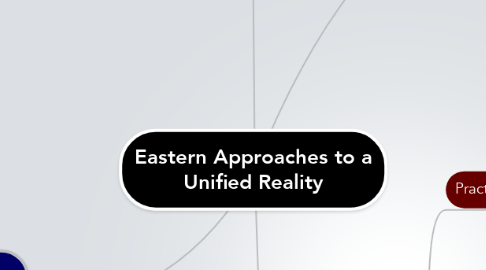
1. Confucianism
1.1. Beliefs
1.1.1. Ren
1.1.1.1. li (ritual norms)
1.1.1.2. zhong (loyalty to one's true nature
1.1.1.3. shu (reciprocity)
1.1.1.4. xiao (filial piety)
1.1.1.5. composed of two graphic elements
1.1.1.5.1. one representing a human being
1.1.1.5.2. The other representing the number two
1.2. Practices
1.2.1. filled by the practices of Chinese religion, Taoism, Buddhism, or other religion which Confucians follow
1.2.1.1. Birth
1.2.1.2. Reaching maturity
1.2.1.3. Marriage
1.2.1.4. Death
1.3. Human Nature and the Purpose of Existence
1.3.1. reach one's highest potential as a human being
1.3.2. junzi is the person who always manifests the quality of ren in his person and the displays the quality of yi in his actions
1.3.3. yi (righteousness)
1.3.4. xiaoren
1.3.4.1. human being who has not learned to put ren into practice
1.3.5. Human beings are teachable, improvable, and perfectible through personal and communal endeavour is typically Confucian
1.4. Ultimate Reality and Divine Beings
1.4.1. human relationships and distinctively human activities bring human beings into contact with the transcendent and communicate something of its nature
2. Taoism
2.1. Beliefs
2.1.1. Taoism does not have a God
2.1.1.1. In Taoism the universe springs from the Tao
2.2. philosophical and religious tradition that emphasizes living in harmony with the Tao
2.3. Ultimate Reality and Divine Beings
2.3.1. Taode jing
2.3.1.1. Tao is the primordial stuff from which all matter emerges
2.3.1.1.1. From Tao a primal matrix of energy spontaneously occurred known as hundun
2.3.2. Tao is not an entity or a divine being
2.3.3. All natural phenomena are generated by the alternation between yin and yang energies
2.3.4. The cycle of existence
2.3.4.1. Wood
2.3.4.2. Fire
2.3.4.3. Water
2.3.4.4. Metal
2.3.4.5. Earth
2.4. Human Nature and the Purpose of Existence
2.4.1. Humans can deviate from the natural order
2.4.1.1. bring destruction upon themselves and those around them
2.4.2. when human nature is aligned with the rest of nature, order and harmony are the result
2.4.3. Purpose of self-cultivation is to return to a mode of existence that is natural
2.5. Practices
2.5.1. methods of nourishing life
2.5.1.1. gymnastics
2.5.1.1.1. physical exercises designed to improve one's health and lengthen life
2.5.1.2. breathing exercises
2.5.1.3. dietary restrictions
2.5.1.3.1. avoidance of grains
2.5.1.4. drinking talisman water
2.5.1.4.1. the ashes of a sacred diagram are drawn on paper, then burned, and the ashes dissolved in water
2.5.1.5. sexual practices
2.5.1.5.1. to generate sexual energy but then redirect it toward the brain, rather than dissipating it through orgasm
3. Hinduism
3.1. Beliefs
3.1.1. Apostasy
3.1.2. Hersey
3.1.3. Blasphemy
3.1.4. Dharma
3.1.4.1. ethics/duties
3.1.5. Samsāra
3.1.5.1. Cycle of life
3.1.6. Karma
3.1.6.1. action and subsequent reaction),
3.1.7. Moksha
3.1.7.1. liberation from samsara
3.1.8. Yoga
3.1.8.1. paths or practices
3.1.9. Concept of God
3.1.9.1. monotheism,
3.1.9.2. polytheism,
3.1.9.3. panentheism,
3.1.9.4. Pantheism,
3.1.9.5. Monism
3.1.9.6. Atheism
3.1.9.7. henotheistic
3.1.9.7.1. Devotion to a single god while accepting the existence of others
3.2. The Ultimate reality
3.2.1. Brahman
3.2.1.1. All-pervading like the sky
3.2.1.2. Basis of all awareness, and source of all bliss
3.2.1.3. Constant witness of the changing phenomena of the universe
3.2.1.4. Two Aspects of Brahman
3.2.1.4.1. transcendent
3.2.1.4.2. immanent
3.3. Sanskrit terms
3.3.1. Atman
3.3.1.1. the individual soul
3.3.2. Seva
3.3.2.1. service
3.3.3. Bhakti
3.3.3.1. path of devotion
3.3.4. Gnana
3.3.4.1. path of knowledge
3.3.5. Dhyana
3.3.5.1. meditation
3.3.6. Satchitananda
3.3.6.1. Supreme unification
3.4. Practices
3.4.1. Seeking awareness of God and blessings from Devas
3.4.1.1. pūjā
3.4.1.2. murtis
3.4.2. symbolism and iconography to represent the sacred in art, architecture, literature and worship
3.4.3. Rituals
3.4.4. Pilgrimage
3.4.5. Festivals
4. Buddhism
4.1. Practices
4.1.1. Reflection
4.1.2. Meditation
4.1.3. Ritual And Devotion
4.1.4. Ethics
4.1.5. Mind And Body
4.2. Nature of reality
4.2.1. dharma
4.2.1.1. manifestation of reality
4.2.2. taught that there were some questions that would lead to pointless metaphysical speculation
4.2.2.1. Am I? Am I not? What am I? How am I? Where has this being come from? Where is it bound?
4.2.3. ultimate reality is samsara, endless existence, but it is also impermanent, ever in flux, ever changing
4.2.4. bhavacakra
4.2.4.1. Wheel of Life and Death
4.2.4.1.1. picts the universe as a series of concentric circles all within the grasp of Mara, the lord of death
4.3. Beliefs
4.3.1. Buddha taught that the gods are not exempt from death and rebirth
4.3.2. disbelief in a creator God
4.3.3. emphasizes practices over beliefs
4.4. Human Nature and the Purpose of Existence
4.4.1. depiction of the universe where all beings reside
4.4.2. The cycle of dependent origination represents a human life cycle
4.4.2.1. Rebirth begins with ignorance. Ignorance gives rise to volition, which leads to consciousness. Consciousness gives rise to a body, which gives rise to the six senses. The six senses lead to contact, which leads to sensations, which lead to desire. Desire gives rise to clinging, which leads to becoming. Becoming leads to birth, which gives rise to old age and death.
